英语词汇学之构词法
- 格式:ppt
- 大小:271.00 KB
- 文档页数:21
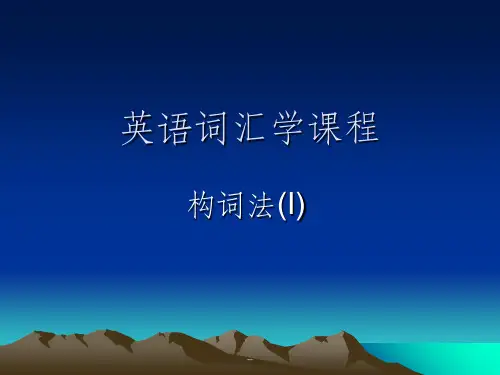
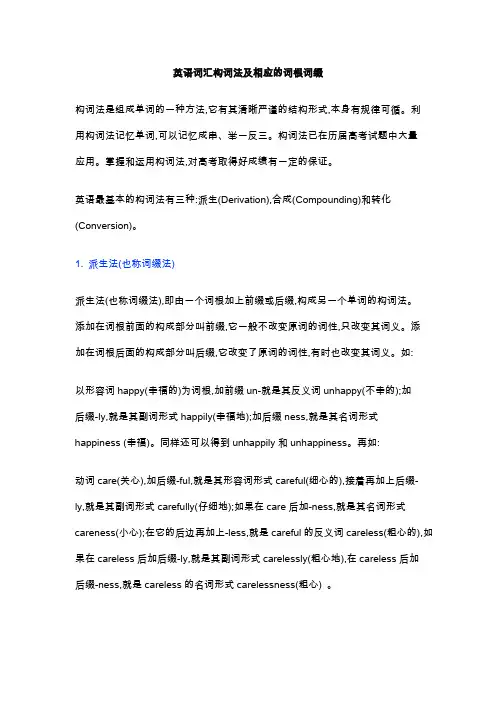
英语词汇构词法及相应的词根词缀构词法是组成单词的一种方法,它有其清晰严谨的结构形式,本身有规律可循。
利用构词法记忆单词,可以记忆成串、举一反三。
构词法已在历届高考试题中大量应用。
掌握和运用构词法,对高考取得好成绩有一定的保证。
英语最基本的构词法有三种:派生(Derivation),合成(Compounding)和转化(Conversion)。
1. 派生法(也称词缀法)派生法(也称词缀法),即由一个词根加上前缀或后缀,构成另一个单词的构词法。
添加在词根前面的构成部分叫前缀,它一般不改变原词的词性,只改变其词义。
添加在词根后面的构成部分叫后缀,它改变了原词的词性,有时也改变其词义。
如:以形容词happy(幸福的)为词根,加前缀un-就是其反义词unhappy(不幸的);加后缀-ly,就是其副词形式happily(幸福地);加后缀ness,就是其名词形式happiness (幸福)。
同样还可以得到unhappily和unhappiness。
再如:动词care(关心),加后缀-ful,就是其形容词形式careful(细心的),接着再加上后缀-ly,就是其副词形式carefully(仔细地);如果在care后加-ness,就是其名词形式careness(小心);在它的后边再加上-less,就是careful的反义词careless(粗心的),如果在careless后加后缀-ly,就是其副词形式carelessly(粗心地),在careless后加后缀-ness,就是careless的名词形式carelessness(粗心) 。
前缀、后缀是构词的要素,具有一定的作用和意义。
懂得了前后缀的含义,就容易了解由前(后)缀和词根结合而成的单词的意义。
现把英语中我们常见的前后缀列举如下:1)前缀anti-反对: antisocial反社会的auto-自: automobile小汽车,autonomy自治bi-双: biannual 一年两次的, bicycle自行车by-在旁:bystander 旁观者, by-product副产品co- 同: co-operation合作,co-existence共处,co-worker同事counter-反:counter-attack反攻,counter-revolutionary反革命的dis-否定,除去: discover发现,disorder混乱,杂乱en-使成为: enable使能够,enslave奴役, encourage鼓励extra-外: extraordinary非常的,格外的for-,fore-,先,前,预: forward向前,foresee 预见,forearm前臂,foretaste先尝for-禁,弃: forbid禁止,forget忘记,forgo放弃in-,il-,im-,ir-不,非: informal非正式的,incomplete不完全的,indefinite不定的, illegal非法的,immoral不道德的,irregular不规则的inter-间,相互:internationalism国际主义,interview会见micro-微: microscope显微镜,microfilm微型胶片mid-中:midday 中午,midnight夜半,mid-autumn中秋的mis-误: misunderstand 误会,misuse误用,misfortune不幸non-非,不:non-moral非道德范围内的,nonsense胡言,nonexistent不存在的post-后于: postwar战后的pre-先于: prewar战前的re-重,再,复: rewrite重写, return返回, review复习super-上,超: superman超人,supermarket 超级商场tele-远: telephone电话,telescope望远镜,television电视un-不: unable不能的,unimportant不重要的,untrue不真实的vice-副:vice-chairman副主席,vice-premier副总理2)后缀-age状态,集合: marriage婚姻, shortage缺少,village 村庄-an人: American美国人,Italian意大利人,意大利籍,African 非洲人-ation,-ition动作,状态:determination决心,industrialization工业化,preparation 准备,competition竞争,repetition重复-dom状态,领界: freedom自由,kingdom王国-eer人: engineer工程师,volunteer志愿者-er人,动作者:fighter战士,worker工人,writer作家,thinker思想家,harvester收割机-ese人,语言:Chinese中国人,中文, Japanese日本人,日文-ess女性:actress女演员,princess公主,goddess女神-hood身分,境遇,状态: childhood 童年,womanhood女性-ian人: musician音乐家, guardian卫护者, Christian基督教徒-ism主义,教:communism共产主义,socialism社会主义,revisionism修正主义-ist主义者,人: communist共产主义者, artist 艺术家-ity (抽象名词): possibility 可能性, ability能力,equality平等-man人: Englishman英国人,英格兰人, postman邮递员-ment运动,结果: movement运动,development发展,judgement判断-ness状态,性质:kindness和善,carefulness小心,correctness正确,tiredness疲倦-or人,动作者: actor男演员,visitor访问者-ship状态,身份: friendship友谊,comradeship同志之友谊,sportsmanship 体育道德,hardship苦难-sion动作,状态: tension紧张状态,revision修订-tion动作,状态: attention注意,action行动-less无:fearless 无所畏惧的,careless 不小心的,useless 无用的,meaningless 无意义的-ly品质,的: comradely 同志般的, friendly 友好的, weekly 每星期的-some引起,适于,易于: troublesome 烦人的,tiresome 令人感到厌倦的2. 合成法(也称复合法) 把两个单词或两个以上的词合成一个新词,这种构词的方法叫做合成法。


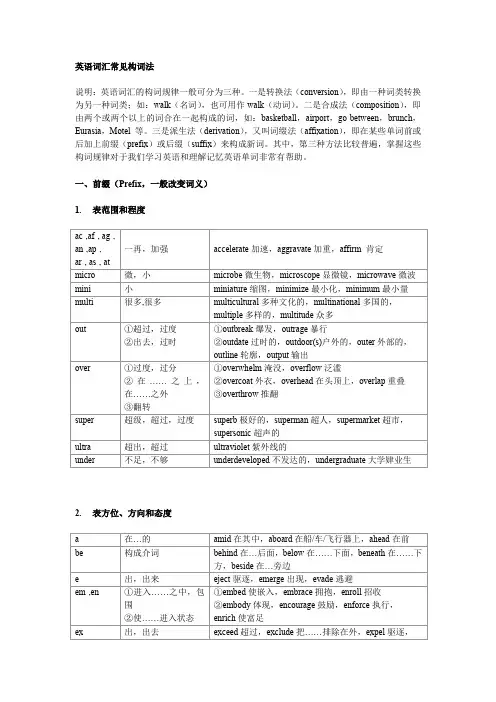
英语词汇常见构词法
说明:英语词汇的构词规律一般可分为三种。
一是转换法(conversion),即由一种词类转换为另一种词类;如:walk(名词),也可用作walk(动词)。
二是合成法(composition),即由两个或两个以上的词合在一起构成的词,如:basketball,airport,go-between,brunch,Eurasia,Motel 等。
三是派生法(derivation),又叫词缀法(affixation),即在某些单词前或后加上前缀(prefix)或后缀(suffix)来构成新词。
其中,第三种方法比较普遍,掌握这些构词规律对于我们学习英语和理解记忆英语单词非常有帮助。
一、前缀(Prefix,一般改变词义)
1.表范围和程度
2.表方位、方向和态度
3.表否定
4.表逆反
5.表数字
6.表贬义
7.其他
二、后缀(Suffix,一般改变词性)
1.名词后缀
2.形容词后缀
3.动词后缀
4.副词后缀。

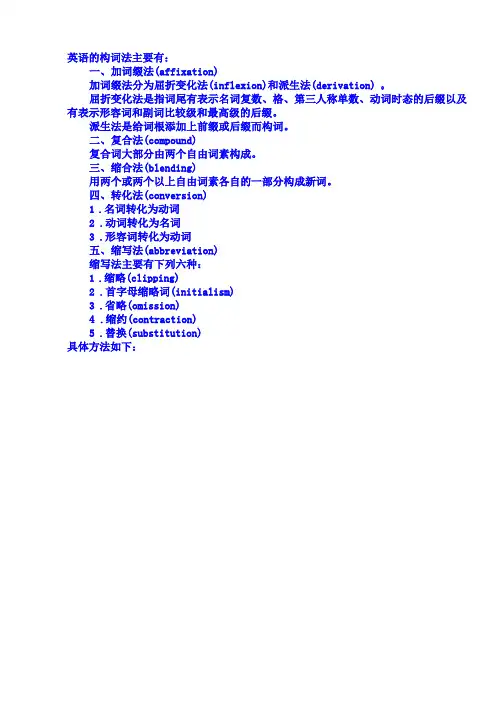
英语的构词法主要有:
一、加词缀法(affixation)
加词缀法分为屈折变化法(inflexion)和派生法(derivation) 0
屈折变化法是指词尾有表示名词复数、格、第三人称单数、动词时态的后缀以及有表示形容词和副词比较级和最高级的后缀。
派生法是给词根添加上前缀或后缀而构词。
二、复合法(compound)
复合词大部分由两个自由词素构成。
三、缩合法(blending)
用两个或两个以上自由词素各自的一部分构成新词。
四、转化法(conversion)
1.名词转化为动词
2.动词转化为名词
3.形容词转化为动词
五、缩写法(abbreviation)
缩写法主要有下列六种:
1.缩略(clipping)
2.首字母缩略词(initialism)
3.省略(omission)
4.缩约(contraction)
5.替换(substitution)
具体方法如下:。

英语构词法归纳和总结
英语构词法主要有以下几种:
1. 转化法:不添加任何词素,而把一个单词由一种词类转化为另一种词类。
例如:hand(n.手)—hand(v.传递),water(n.水)—water(v.浇水),等。
2. 派生法:在词根前面加前缀或在词根后面加后缀,从而构成一个与原单词意义相近或截然相反的新词。
例如:unable(不能),unhappy(不高兴),等。
3. 合成法:把两个或两个以上的单词结合在一起,构成一个新词。
例如:blackboard(黑板),classroom(教室),等。
4. 截短法:把一个较长的单词截取一部分,从而构成一个新词。
例如:photo(照片)—photo,zoo(动物园)—zoo等。
5. 首尾字母结合法:取单词的首尾字母,从而构成新词。
例如:bus(公共汽车)—ABS防抱死刹车系统,fan(扇子)—fanfare喇叭声等。
6. 混成法:把两个词各取一部分结合在一起构成一个新词。
例如:smoke and fog(烟雾),television (电视)等。
7. 音变构词法:通过发音的变化来构成新词。
例如:knife-knives,live-lives,man-men等。
以上就是英语构词法的归纳和总结,希望对你有所帮助。
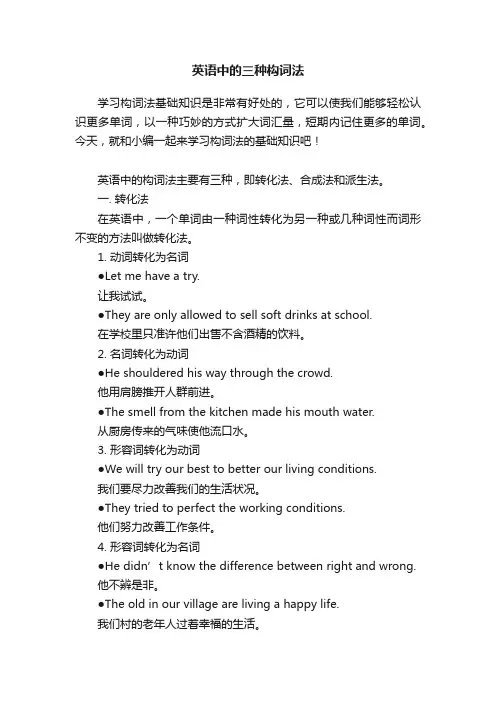
英语中的三种构词法学习构词法基础知识是非常有好处的,它可以使我们能够轻松认识更多单词,以一种巧妙的方式扩大词汇量,短期内记住更多的单词。
今天,就和小编一起来学习构词法的基础知识吧!英语中的构词法主要有三种,即转化法、合成法和派生法。
一. 转化法在英语中,一个单词由一种词性转化为另一种或几种词性而词形不变的方法叫做转化法。
1. 动词转化为名词●Let me have a try.让我试试。
●They are only allowed to sell soft drinks at school.在学校里只准许他们出售不含酒精的饮料。
2. 名词转化为动词●He shouldered his way through the crowd.他用肩膀推开人群前进。
●The smell from the kitchen made his mouth water.从厨房传来的气味使他流口水。
3. 形容词转化为动词●We will try our best to better our living conditions.我们要尽力改善我们的生活状况。
●They tried to perfect the working conditions.他们努力改善工作条件。
4. 形容词转化为名词●He didn’t know the difference between right and wrong.他不辨是非。
●The old in our village are living a happy life.我们村的老年人过着幸福的生活。
5. 形容词转化为副词●How long have you lived there?你在那儿住多久了?6. 个别词在一定场合中可转化为名词●Warm clothes are a must in the mountains.穿暖和的衣服到山区去是必须的。
●Life is full of ups and downs.人生有得意时也有失意时。

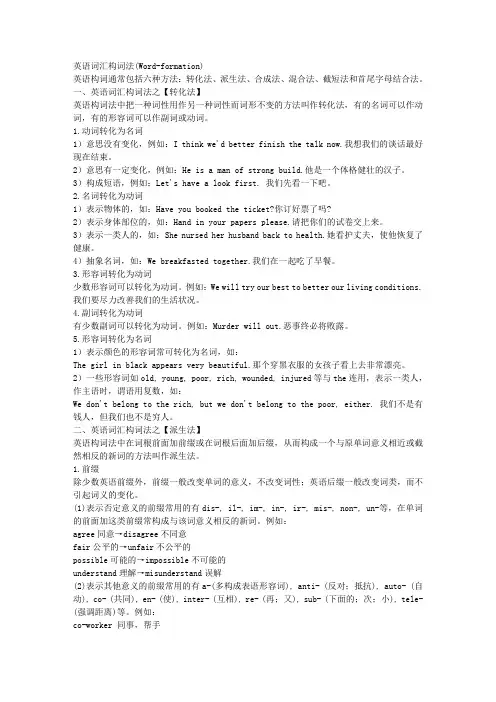
英语词汇构词法(Word-formation)英语构词通常包括六种方法:转化法、派生法、合成法、混合法、截短法和首尾字母结合法。
一、英语词汇构词法之【转化法】英语构词法中把一种词性用作另一种词性而词形不变的方法叫作转化法,有的名词可以作动词,有的形容词可以作副词或动词。
1.动词转化为名词1)意思没有变化,例如:I think we'd better finish the talk now.我想我们的谈话最好现在结束。
2)意思有一定变化,例如:He is a man of strong build.他是一个体格健壮的汉子。
3)构成短语,例如:Let's have a look first. 我们先看一下吧。
2.名词转化为动词1)表示物体的,如:Have you booked the ticket?你订好票了吗?2)表示身体部位的,如:Hand in your papers please.请把你们的试卷交上来。
3)表示一类人的,如:She nursed her husband back to health.她看护丈夫,使他恢复了健康。
4)抽象名词,如:We breakfasted together.我们在一起吃了早餐。
3.形容词转化为动词少数形容词可以转化为动词。
例如:We will try our best to better our living conditions.我们要尽力改善我们的生活状况。
4.副词转化为动词有少数副词可以转化为动词。
例如:Murder will out.恶事终必将败露。
5.形容词转化为名词1)表示颜色的形容词常可转化为名词,如:The girl in black appears very beautiful.那个穿黑衣服的女孩子看上去非常漂亮。
2)一些形容词如old, young, poor, rich, wounded, injured等与the连用,表示一类人,作主语时,谓语用复数,如:We don't belong to the rich, but we don't belong to the poor, either. 我们不是有钱人,但我们也不是穷人。
英语四个构词法(最新版)目录1.英语构词法的概述2.英语构词法的分类3.构词法的具体用法和例子4.学习构词法的重要性5.总结正文英语四个构词法英语构词法指的是英语单词是如何通过不同的方式组成新单词的。
英语单词的构成方式有很多种,但最常见的构词法主要包括以下四种:前缀法、后缀法、词根法和复合法。
1.前缀法前缀法指的是在单词前面加上一个前缀来构成新单词。
前缀可以是单词、字母或者符号,它们通常用于改变单词的意思。
例如,单词“happy”(快乐) 加上前缀“un”(不),就可以构成新单词“unhappy”(不快乐)。
2.后缀法后缀法指的是在单词后面加上一个后缀来构成新单词。
后缀也可以是单词、字母或者符号,它们通常用于改变单词的词性。
例如,单词“happy”(快乐) 加上后缀“-ness”(名词后缀),就可以构成新单词“happiness”(快乐)。
3.词根法词根法指的是通过将单词分解成词根来构成新单词。
词根是单词的基本部分,通常是一个或多个字母。
例如,单词“correct”(正确) 可以分解成词根“cor”(共同) 和“rect”(直),然后通过加上后缀“-ly”(副词后缀) 来构成新单词“correctly”(正确地)。
4.复合法复合法指的是将两个或多个单词组合在一起来构成新单词。
例如,单词“book”(书) 和“shop”(商店) 可以组合在一起构成新单词“bookshop”(书店)。
学习构词法对于学习英语非常重要。
它可以帮助我们更好地理解单词的意思和用法,并且可以帮助我们更容易地记住单词。
通过学习构词法,我们可以更好地掌握英语单词,提高我们的英语水平。
英语八大构词法英语八大构词法又称为八大组块法,是指英语中最常用的八种构词方式。
它们分别为:复合,介词-形容词,動名詞,副詞,省略,変化,动词,单词片断组合法。
一、复合(Compounding):把两个或以上的词结合起来组成一个新的词。
比如:blackboard(黑板),pickpocket(扒手)。
二、介词-形容词(Prepositional-Adjective):在英语中,介词和形容词不可分割,构成一个新的词。
比如:over-excited(过度激动),out-of-date(过时的)。
三、動名詞(Verbal Nouns):由动词的不定式、分词或动词加上-ing形式构成。
比如:睡眠时,sleeping(睡);写作时,writing(写)。
四、副詞(Adverbs):由名词、形容词、动词及其派生词构成,也包括量詞、助词等。
比如:sometime(某个时候),hereafter(今后),someway(以某种方法)。
五、省略(Ellipsis):省略某部分,但仍可以理解。
比如:ad (广告),bus(公共汽车),doc(医生)。
六、変化(Inflections):在词尾变化,形成新的词,常用词尾有:-s, -ed, -ing等。
比如:speak(说话)-speaks(说),walk (走)-walking(走)。
七、动词(Verbs):动词构成方式大都是复合、介词-形容词等,也可以直接改变动词的时态等变化而成新词。
比如:buy(买)-bought(买),drink(喝)-drank(喝)。
八、单词片断组合法(Word-Fragment Combination):把构成单词的片断组合起来,构成短语或新词。
比如:break(折断)+through(通过)=breakthrough(突破)。
英语八大构词法是一种有效的英语学习方法,使用者能够更全面、更系统的了解和掌握单词的构成方式和意思,从而更好地提高学习英语的效率。
英语量化记忆法之7种英语构词法7种英语构词法目录7种英语构词法 (2)一、派生法 (2)二、转化法 (3)三、合成法 (6)四、逆成法 (8)五、混成法 (8)六、截短法 (9)七、首尾字母缩略法 (9)7种英语构词法一、派生法派生法:在一个单词的前面或后面加上词缀构成新词的方法,称为派生法。
派生构词有三大要素:词根、前缀和后缀。
也有人称之为两大要素:自由词素和粘附词素。
派生法的结构是:粘着词素+自由词素+粘着词素。
(一)英语词缀分成前缀和后缀两种。
前缀是加在词根或单词前面的部分。
它具有一定的含义。
同一词根或单词加上不同的前缀,即可构成不同的新词。
pre—(前):prewar (战前的)post—(后):postwar(战后的)im—(入):import (输入)前缀可以增加、改变或加强一个词根或单词的意义,也可以改变一个单词的词类。
如:增加意义:hemi-(半)→ hemisphere(半球)改变意义:un-(不)→ unhappy(不快乐的)加强意义:de-→ describe(描写)改变词类:en-(使)→ enlarge(扩大)前缀的意义主要有这几种:1、表示否定意义,如:anti-: anticancer抗癌剂2、表示数目和数量,如:multi-: multicolored多彩的3、表示时间、空间和程度,如:a-: aboard在船上4、表示特殊意义,如:auto-: autobiography自传后缀是加在词根或单词后面的部份。
后缀有四种,即:名词后缀、形容词后缀、动词后缀和副词后缀。
后缀不仅改变词的意义,而且使单词由一种词类转化成另一种词类。
1、名词后缀,如:表示人:-er: worker工人; teacher教师-ist: artist艺术家; chemist药剂师表示物:-or: tractor拖拉机; generator发电机-ant: disinfectant消毒剂; dependant依附物表示抽象名词:-hood: childhood童年; neighborhood邻居关系-ship: friendship友谊; horsemanship骑马术表示集合名词:-ry: peasantry农民总称; citizenry公民总称-age: mileage英里数; teenage十几岁的时期表示场所地点:-ery: piggery养猪场; greenery花房,温室-ern: saltern制盐场; cavern洞穴表示疾病:-oma: trachoma沙眼症; neuroma神经瘤-itis: bronchitis支气管炎; arthritis关节炎表示……学:-logy: zoology动物学; anthropology人类学-ics: electronics电子学; statistics统计学2、形容词后缀:表示一种事物具有或属于某种性质或状态。
史上最全的构词法用法详解史上最全的构词法用法详解构词法语言中词的总和构成词汇,但是词汇并不是一堆杂乱无章、互不相关的群体,而是一个严密体系,在这个结构的体系中,词与词之间有着各种各样的联系。
英语中的这些联系的规律总结起来就是构词。
英语中构词的方法就是构词法。
构词法主要有合成法、转化法、派生法和缩略法四种。
掌握构词法是迅速扩大词汇量的重要方法之一。
第一节合成法合成法就是指由两个或两个以上的单词合成的词叫合成词。
这种构词方式主要有两种:复合法、结合法。
合成法主要是构成合成名词和合成形容词。
复合法构成的复合词,它们各个结合的部分相互间的语法关系是紧密相关的。
如blackboard和darkroom都是形容词和名词形成的结构,writing desk是动词名词和名词形式的结构。
结合法形成的词是形态合成词,它的结合是用一个起来连接作用的中缀来把两个或两上以上的词根词素紧紧的连缀在一起。
如,用辅音字母-s-来缀全两个词根词素构成的词有:salesman, townspeople等。
合成的方式常见的有如下几种:一、合成名词1、名词/代词+名词:woman-doctor, women-doctors, workshop, spaceship, he-goat, coal fire, motorcycle, gas cooker, oil well, power plant, silk worm, gold mine, bottleneck, piano keys, telephone receiver, television screen, chairman, fireman, motorman, police-officer, postman, pine tree, girl friend, boy friend, goldfish, raindrop, birdcage, breakfast time, flowerbed, tearoom,2、动词+名词:blowpipe, flashlight, watchdog, call-girl, searchlight3、形容词+名词:blacksmith, blackboard, supermarket, superman, darkroom, blackbird, highchair, hothouse, greenhouse, madman4、动名词+名词:reading-room, sitting-room, classroom, schoolroom, dining room, building materials, dancing girl, cleaning women, flying machine, washing machine, working conditions, boilding point, drinking water, swimming pool, drinking cup, typing paper, writing desk, sewing machine, walking stick,5、名词+动名词:machine-building, shoe-making, paper-correcting, book-keeping, dressmaking, letter-writing, story-telling, town-planning, handwriting, sun-bathing, horse riding, churchgoing, daydreaming6、动词+副词:stand-by, take-off, cut-off, breakdown7、副词+名词:downfall, rainfall, outhouse8、现在分词+名词:running dog, running water, flying fish, rising sun, burning stick,9、名词+介词+名词:man-of-war, editor-in-chief,10、名词+连词字母+名词:handiwork, nowadays11、介词/副词+名词:afternoon, inland, overbalance二、合成形容词1、形容词+名词+ed:five-storeyed, one-eyed, double-faced, blue-eyed,2、名词+名词+ed:honey-mouthed,3、名词/代词+分词:man-made, heart-broken, self-educated, snow-covered, man-eating, peace-loving, paper-making, ocean-going, heartfelt, handmade, home-made, sunburnt, weather-beaten4、名词/代词+形容词:color-blind, ice-cool, seasick, airsick, tax-free, grass-green, snow-white, rock-hard, sea-green5、形容词/数词+名词:full-time, high-grade, second-hand,6、形容词/数词+分词:ready-made, sleepy-looking, good-looking,7、副词+分词:far-reaching, so-called, hard-working, far-reaching, well-meaning, newly-laid, well-meant, wide-spread8、副词+形容词:ever-green, under-ripe,9、形容词+形容词:dark-blue, red-hot, grey-green10、介词+名词:downhill, overnight三、合成副词1、形容词+名词:sometimes, meanwhile2、副词+名词:oftentimes, indoors, outdoors, overhead3、介词+名词:alongside, beforehand4、名词+形容词:skyhigh, stonestill,5、副词+介词:nearby, upalong,四、合成动词1、名词+动词:overhear, underline2、形容词+动词:moonwalk3、副词+动词:white-wash, safeguard五、其它合成词1、合成代词:everybody, everyone, everything, anyone, anybody, anything2、合成介词:outside, inside, throughout第二节转化法不用借助构词词缀,把一个单词从一种词类转化成另一种词类的方法就是转化法。